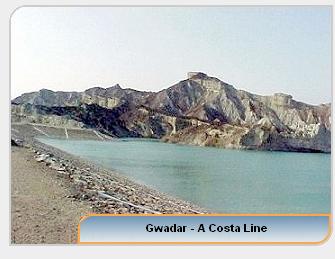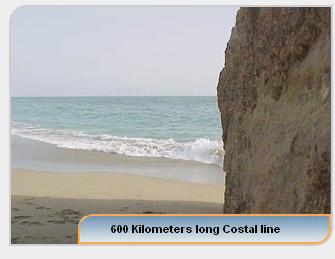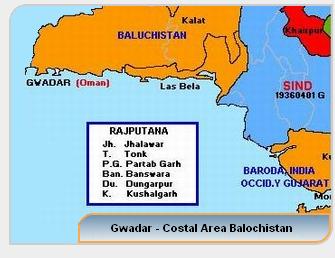Gwadar
district, with its 600 kilometres long coast line and un-irrigated
tracts of Kulanch and Dasht valleys, has always been an important
chapter of Makran’s history. The known history of Makran goes back
to the time of prophet Dawood when people entombed themselves to
avoid famine. The area is said t o
be possessed by Iranian King Kaus followed by Afrasiab of Turan
and then by Kai Khusrau, again an Iranian. Then there is a long
list of rulers, including Lehrasp, Gushtasp, Bahman, Huma and
Darab, to the year 325 BC when Alexander the Great incidentally
found the sea in this area on his way from India to Macedonia.
Greek historian Arrian has mentioned the coast line as the country
of Ichthyophagoi. At that time Nearchos, the admiral of Alexander,
sailed along the coast and mentioned places named Kalmat, Gwadar,
Pishukan and Chahbar. Afterwards, the area was ruled by Seleukos
Nikator, one of Alexander’s generals, who lost it to Chandragupta
in 303 BC. Then the tract of history is lost in darkness for
centuries. An account of this area is found in the beginning of
the sixteenth century when the Portuguese found their way to India
and captured several places along the Makran coast. In 1581 they
burnt “the rich and beautiful city of Pasni” and Gwadar. Although
many invaders conquered the land, mostly the local rulers,
including Hots, Rinds, Maliks, Buledais and Gichkis, exercised
authority in the area as the conquerors had no intentions to stay
there.
o
be possessed by Iranian King Kaus followed by Afrasiab of Turan
and then by Kai Khusrau, again an Iranian. Then there is a long
list of rulers, including Lehrasp, Gushtasp, Bahman, Huma and
Darab, to the year 325 BC when Alexander the Great incidentally
found the sea in this area on his way from India to Macedonia.
Greek historian Arrian has mentioned the coast line as the country
of Ichthyophagoi. At that time Nearchos, the admiral of Alexander,
sailed along the coast and mentioned places named Kalmat, Gwadar,
Pishukan and Chahbar. Afterwards, the area was ruled by Seleukos
Nikator, one of Alexander’s generals, who lost it to Chandragupta
in 303 BC. Then the tract of history is lost in darkness for
centuries. An account of this area is found in the beginning of
the sixteenth century when the Portuguese found their way to India
and captured several places along the Makran coast. In 1581 they
burnt “the rich and beautiful city of Pasni” and Gwadar. Although
many invaders conquered the land, mostly the local rulers,
including Hots, Rinds, Maliks, Buledais and Gichkis, exercised
authority in the area as the conquerors had no intentions to stay
there.
Two regimes of
local rulers, of Buledais and Gichkis, are worth mentioning here.
The Buledais gained power with the rise of the Zikri sect. These
rulers are said to be connected with the rulers of Maskat and were
called Buledais with reference to the valley of Buleda where they
resided. The Buledais ruled the area for more than a century up to
the year 1740. In the last years of their regime they embraced
Islam. The Zikri folk joined hands with the Gichkis who also were
Zikris by faith. The family feuds and internal dissension between
Gichkis resulted in nine successful expeditions (either partially
or fully) by Mir Nasir Khan I. It is said, that the main motive
behind all these expeditions, made by Mir Nasir Khan I, was to
eliminate the Zikris as he belonged to the (anti-Zikri) Muslim
faith. These expeditions resulted in a division of revenues
between the Khan and Gichkis.
In the last
quarter of the eighteenth century, Gwadar and the surrounding
country fell into the hands of Maskat. Saiad Said succeeded to the
masnad of Muscat in 1783 and had a dispute with his brother Saiad
Sultan. The latter appears to have fled to Makran and entered into
communication with Nasir Khan who granted him the Kalat share of
the revenues of Gwadar. Saiad Sultan lived at Gwadar for some time
and eventually succeeded in usurping the Sultanate of Maskat in
1797. He died in 1804 and during his sons reign, the Buledai chief
of Sarbaz, Mir Dosten, is said to have acquired temporary
possession of Gwadar, but a force sent from Maskat regained it.
Although it is generally understood that the right of sovereignty
in Gwadar was transferred by the Khans of Kalat to Maskat in
perpetuity, the Khans and natives of Gwadar have always denounced
this perception. The un-irrigated tracts of Kulanch and Dasht
valleys have always been connected with Kech.
The first
Afghan war (1838-39) directed attention of the British to the
area. Major Goldsmith visited the area in 1861 and an Assistant
Political Agent was appointed in Gwadar in 1863. Both Pasni and
Gwadar have been ports of call for the steamers of the British
India Steam Navigation Company. The first ever telegraphic link to
this area was made in 1863 when Gwadar was linked to Karachi.
Telegraph offices were opened at Gwadar and Pasni. Later post
offices were opened at Gwadar in 1894 and at Pasni in 1903. Ormara
was linked telegraphically in 1904.
After the
division of the Indian subcontinent into two sovereign states,
areas except Gwadar and its surroundings, joined the Balochistan
States Union, as part of Makran state. In early 1949 along with
Kalat, Lasbela and Kharan. In October 1955, Makran was given the
status of a di strict of former West Pakistan province after its
accession to Pakistan. In 1958, Gwadar and its surrounding area
was reverted back from Maskat to Pakistan and was made a tehsil of
Makran district. On 1st July 1970, when one unit was dissolved and Balochistan gained the status of a province, Makran became one of
its 8 districts. On 1st July 1977, Makran was declared a division
and was divided into three districts, named Panjgur, Turbat
(renamed Kech) and Gwadar. Gwadar was notified as a district on
July 1, 1977 with its headquarters at Gwadar town.
strict of former West Pakistan province after its
accession to Pakistan. In 1958, Gwadar and its surrounding area
was reverted back from Maskat to Pakistan and was made a tehsil of
Makran district. On 1st July 1970, when one unit was dissolved and Balochistan gained the status of a province, Makran became one of
its 8 districts. On 1st July 1977, Makran was declared a division
and was divided into three districts, named Panjgur, Turbat
(renamed Kech) and Gwadar. Gwadar was notified as a district on
July 1, 1977 with its headquarters at Gwadar town.
A stone-built
domed shrine of some saint at Gwadar is said to be centuries old.
It may be the same one indicated in the Gazetteer of Balochistan.
A square fort along with a tower is present amidst the Memon
Muhallah of Gwadar. It is near the old bungalow of the Assistant
Political Agent to the Governor General (therefore renowned as
governor’s house). Moreover, the fort of Saiad Sultan is still in
good condition and is being used as a police station.

